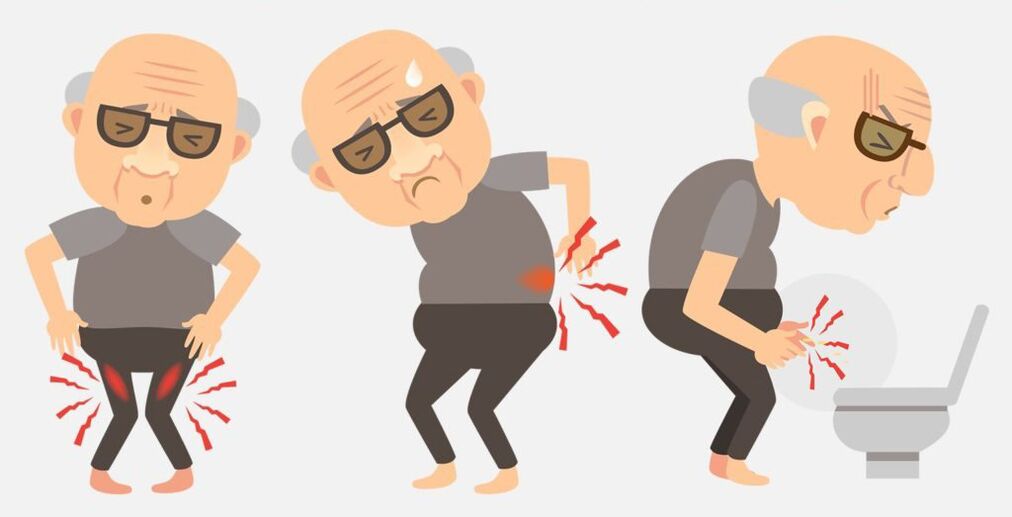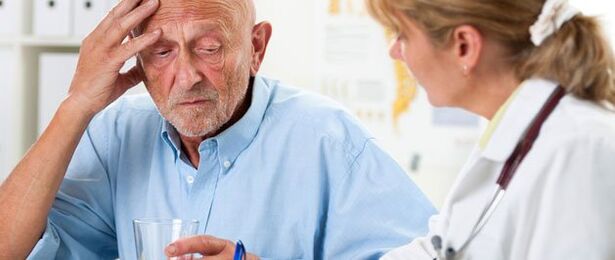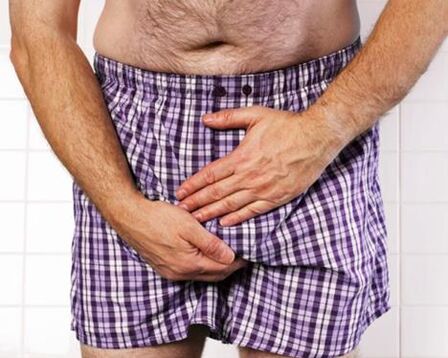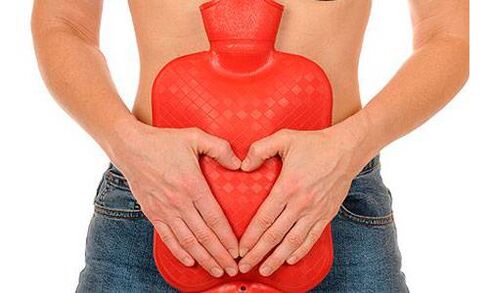At first glance, the symptoms of male prostatitis are not characteristic and specific. This is why in modern urology and andrology, more and more men are diagnosed with infertility in the most active reproductive layer of 25 to 40 years old. The male prostate is an organ that performs multiple functions: barrier, regulation of blood coagulation, endocrine, reproduction, mating (sex), bladder sphincter. The signs and symptoms of male prostatitis are multifaceted, especially in the chronic form-they cover all organ functions and are often difficult to diagnose.
Symptoms of acute prostatitis in men

What are the symptoms of male prostatitis that should attract your attention and see a doctor? Every man, especially at a young and sexually active age, needs to understand the signs of inflammation in the lower genital tract and the possible clinical manifestations of early prostate disease. Many young people postpone going to see a urologist, believing that the disease belongs to the elderly.
important.
Prostate inflammation is based on a series of factors, which start to play a role in the age of 20-30.
- Sexual infection is the first thing that triggers an active or slow inflammatory process. Chlamydia, mycoplasma infections, gonorrhea, trichomoniasis, and Gardnerella cause urethritis, which may lead to the development of glandular inflammation. Herpes simplex virus, human papilloma virus, and CMV virus, if they do not cause gland inflammation, will significantly aggravate the process of sexually transmitted infections and "pave the way" for bacteria in organs and tissues. In the context of genital infections, opportunistic flora (Staphylococcus, E. coli) usually cause prostate disease. At the time of diagnosis, mixed flora is often found.
- Sitting and working for a long time is one of the factors that induce the disease. This occupational hazard or habit can adversely affect the health of the prostate.
- Sexual life with arrhythmia-its rarity or randomness, psychological problems that cause delayed or non-ejaculation, erectile dysfunction, and frequent masturbation-severely disrupts the balance of arterial and venous blood flow in the glands.
- The impact of cold on the waist, abdomen and limbs-winter sports and entertainment, occupational hazards associated with hypothermia, can cause irreversible changes in glandular tissue.
Sexual infection, chronic hypothermia, venous blood and prostate secretion stasis lay the foundation for the formation of chronic prostatitis. . . The inflammatory symptoms of various forms of prostatitis are combined into three syndromes: pain, libido and dysuria (dysuria). One of the predominant reasons is to see a doctor-a urologist, sexologist, therapist or surgeon. The alertness and qualifications of the doctor will determine the speed of the healing process.
The symptoms of acute prostatitis are observed after or at the same time as active genital infection, and are characterized as follows:
- Discomfort and soreness when urinating.
- Cut at the beginning or end of urination.
- Frequent and false impulses to go to the toilet.
- Pain around the anus, especially when sitting.
- Soreness during defecation and a feeling of fullness in the rectum.
- There is mucopurulent discharge from the urethra.
- The abdominal pain radiates to the thighs, scrotum, and back.
- fever.
- Sexual dysfunction.
Each patient has different degrees of symptom severity. In addition, only certain symptoms may dominate. However, there are usually no symptoms during the acute process, which ensures frequent chronicization and an increase in the number of confirmed cases of chronic prostatitis.
The first sign of prostatitis
Young men develop symptoms of prostatitis in the form of acute respiratory infections or typical genital infections. Depending on the type of pathogen, the signs of the acute process may brighten or disappear.
The symptoms of male prostatitis caused by Neisseria gonorrhoeae, Staphylococcus aureus, and Escherichia coli and the characteristics of hospital infection (after urinary tract operation) are as follows:
- The patient suddenly felt a chill, which lasted for half an hour to two hours, and ended with sweating.
- The temperature rose to 38-40 °C.
- It is characterized by weakness and severe weakness.
The first symptoms of male prostatitis may not accompany the characteristic pain in the pelvic area, rectum, and groin. . . In addition, sexual weakness is not a feature. On the contrary, the catarrhal first stage of the disease is manifested as hyperexcitability and premature ejaculation.
important.
Chlamydia in the genitourinary tract often causes chronic prostatitis, with only mild dysuria symptoms at first.
How does prostatitis manifest itself in men, caused by blood-borne or lymph-derived flora entering the prostate tissue? This type of disease that accompanies general physical infections (sinusitis, sore throat, pneumonia, abscess, pustular skin disease) may not be noticed by patients. Under the background of the underlying disease, the body temperature rises again, the symptoms of poisoning are aggravated, and mild dysuria and abdominal pain may occur.
Symptoms of chronic prostatitis in men

Bacterial or viral, congestive or infectious chronic prostatitis has different symptoms, because although the inflammatory process is caused by different triggers, it will lead to three basic manifestations:
- Pain syndrome.
- Urination disorders.
- Sexual dysfunction.
The pain symptoms of prostatitis are also divided into three types:
- External genitalia-pain in the rectum, lower back, and abdomen is characteristic.
- Pelvis-pain symptoms do not appear, but the anus is obviously itching, tingling, paresthesias, neurosis, excessive sweating-this is due to the involvement of the pelvic nerve plexus in the process.
- Genitals-pain in the scrotum, low back pain in the testicles, groin and perineum.
- mix.
The painful symptoms of prostatitis formed the concept of "male chronic pelvic pain syndrome".
The symptoms of chronic prostate inflammation are accompanied by violations and suppression of erections, ejaculation, and decreased libido. In this context, a neurosis-like syndrome is formed, which proceeds according to the sympathetic or parasympathetic type. The first feature is heartbeat, fever, sub-heat at night, sudden changes in mood, and inattention. The second-daytime sleepiness, fatigue, night insomnia, hypochondriasis, hyperhidrosis, weight gain, lump in the throat, excessive salivation.
Among the symptoms of dysuria are increased urination, difficulty in emptying the bladder, dripping and running water, lethargy. These signs have obvious similarities to adenomas and sometimes complicate the diagnosis.
important.
Chronic prostatitis in men after 45 years of age often occurs simultaneously with benign prostatic hyperplasia.
In the chronic form, spermatorrhea and prostatic fluid are observed-due to organ weakness, the prostatic secretions in the urethra combine with the seminal fluid.
Asymptomatic prostatitis
Prostate inflammation is not always symptomatic. Usually, a person will be diagnosed with ultrasound during family planning to learn about a certain disease. They found calcification of prostate tissue, occlusion of ducts, enlarged or reduced glands, hardening, impaired blood flow according to Doppler ultrasound, and varicose veins in the prostate plexus and small pelvis.
Young men experience symptomatic prostatitis after experiencing genital infections, especially urogenital chlamydia and mycoplasma infections.Especially after inadequate and incomplete treatment of these diseases, asymptomatic prostatitis was recorded. Normally, when examining sperm, you will find a decrease in the number of germ cells, a decrease in motile cells, agglutination, and a decrease in lecithin particles. Periodic sexual failure is possible, and men don't take this seriously.

Symptoms of worsening prostatitis
When exposed to unfavorable predisposing factors, chronic prostatitis can worsen-general physical illness, hypothermia, irregular sexual activity, alcohol abuse, genitourinary organs, and the worsening of rectal infectious diseases.
The symptoms of worsening male prostatitis are similar to the onset of the disease. Body temperature rises, general malaise, fatigue, weakness, and chills appear. Anal pain, a feeling of fullness in the rectum, low back pain in the groin, and growing perineum. Sexual dysfunction and neuroticism will also increase. When going to the toilet, the patient noticed difficulty urinating, increased urination, weakened urine flow, and pain.
The course characteristics of certain types of prostatitis
How does prostatitis manifest in men? Generally, according to the epidemic process, several types of diseases can be distinguished: infectious, bacterial, stagnant, and purulent.
Infectious and bacterial prostatitis
The concept includes several forms of classification of the disease, or more precisely, the distinction based on the type of pathogen causing the disease. The symptoms of infectious prostatitis can only be caused by pathogenic bacteria and viruses, and can be caused by sexual transmission and opportunistic pathogens. Conditional pathogenic microorganisms that usually inhabit the male genitourinary tract can cause disease only under unfavorable factors. In most cases, E. coli, Staphylococcus, and Enterococcus will be found when inoculating semen and urine. This is bacterial prostatitis.
Infectious prostatitis accounts for the vast majority of young people.This type of prostate inflammation most often causes chronicity and leads to infertility.
The clinical feature is that gonorrhea is the most obvious, chlamydia, mycoplasma and opportunistic pathogens, with few symptoms, so it often leads to chronic prostatitis.

Purulent prostatitis
The pyogenic flora is represented by Neisseria gonorrhoeae, Pseudomonas aeruginosa, Escherichia coli, and methicillin-resistant Staphylococcus strains. These microorganisms secrete many destructive enzymes, which are characterized by aggressiveness to the prostate tissue and therefore cause purulent fusion.Usually, purulent prostatitis ends with abscess, sputum, prostatitis, and prostatitis.
The purulent process is usually triggered by bacteria that enter the prostate in the following ways:
- Suppurative foci from other organs.
- Used for medical intervention of genitourinary organs. The hospital flora is characterized by multi-drug resistance to antibiotics, so it just leads to purulent prostatitis.
The symptoms of purulent prostatitis are most pronounced and usually cause complications: urinary fistula and vesicoenteric fistula. Moreover, these bacteria can easily enter the kidney, pelvis and renal calyx through the ascending channel, causing their chronic inflammation.
Congestive prostatitis
The isolated course of this disease is actually excluded because, in the context of the stagnant process, the microbial flora is attached and this type of course is infectious. In most cases, the urologist will make this diagnosis if the bacteria are not isolated during the inoculation of the biological material. Usually, the analysis performed after 2-3 weeks has given a positive result for the flora.
Venous blood stasis is often observed together with varicose veins, rectal disease, pelvic tumors, and fatigue. The most frequently observed violation of prostate secretions in sexual dysfunction and irregular sexual activity can lead to a prerequisite for stagnation and inflammation.Symptoms of congestive prostatitis and infectious inflammation occur at the same time, they are inseparable and interdependent.Symptoms will be supplemented by varicose veins and rectal disease.
Obviously, the performance of chronic prostatitis may be non-specific, which requires a thorough comprehensive diagnosis.
important.
Any signs of male genital infection should be a reason to contact a urologist or venerologist for treatment.
Self-treatment or ignorance of the situation can become the driving force for the formation of chronic diseases.

























